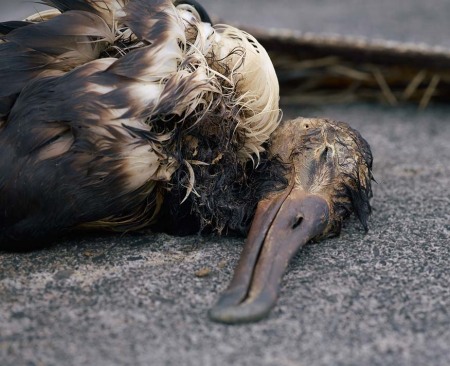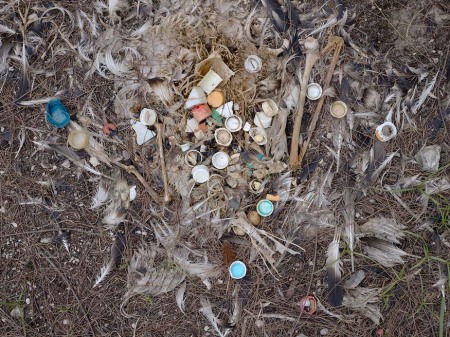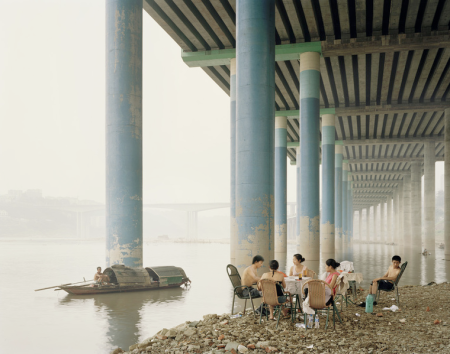From Maya Lin, the acclaimed sculptor and artist.
Maya Lin’s “Unchop a Tree” Video
January 26, 2010Chris Jordan– Midway
November 30, 2009The Great Pacific Garbage Patch within the North Pacific Gyre, is now twice the size of Texas, and still many people are not yet aware of it. The patch is a result of marine pollution such as dumping from large ships, as well as every day litter on beaches and coast. But most of it, believe it or not, is garbage that has been blown by wind off of land. In fact, an estimated 80% of the garbage in the patch comes from land based sources, whereas only 20% comes from ships. What exactly is in the patch? Plastic. The answer is always plastic. Plastic is a synthetic material invented by man that never degrades. Some love it just for that reason.
Unfortunately, this is plastic’s biggest fault. Our culture of disposable plastics like bottled water, packaging, grocery bags, single serving containers, etc. has not yet replaced “real plastic” with green biodegradable versions. Plastic does not biodegrade, it just photo degrades, meaning that it breaks down visually until it becomes so small and invisible while still maintaining its toxic molecular structure that it makes its way into the food source of the smallest of aquatic organisms– plankton. The key to life in the oceans. Plankton is the most abundant life form on earth, and now in the plastic gyre, it is found only 1 to each 7 pieces of floating plastic.
This isn’t the only organism to ingest our plastic waste– sea turtles, fish, jelly fish, and others– are all known to have mistaken brightly colored bits of plastic as food. Not only is the plastic non-ingestible and can do all sorts of harm to their stomachs and throats (imagine swallowing a frisbee every day), but plastic contains a host of toxic chemicals like cancer causing BPA (bisphenol A) and Polysterene (which contains poisons like flame retardants and benzene, known carcinogens). The plastic also absorbs other organic pollutants in the water like DDT (the banned pesticide), PCBs (polychlorinated biphenyls) and others which are known as endocrine disrupters, meaning that they alter the levels and state of hormones of the animals that ingest them. And this isn’t just about the fish turning androgynous– the humans like us that eat them can be greatly affected too. All those warnings about women eating fish during pregnancy? They’re not only because of mercury content, but also because of toxic chemicals that have been absorbed by sealife through the ingestion of plastics which have in turn absorbed these chemicals.
One of the animals most greatly affected is the Albatross. This starring character from Coleridge’s The Rhyme of the Ancient Mariner is severely threatened by our current consumptive habits. Specifically, the Black Footed Albatross and Laysan Albatross, who make their home on isolated tropical islands in the North Pacific Gyre, are currently considered an endangered species. Not only are they accidentally caught by longline fishing, but they are prone to eating the colorful pieces of floating plastic that resemble food in the garbage patch. The plastic causes all sorts of havoc in their stomachs, and leaves them full with less room for real food. Parents of albatross chics bring these plastic bits resembling food back to their hungry chics, who’s stomachs fill up too quickly with poisons and in-digestible materials. They barely make it a few months on this diet.
Chris Jordan, a photographer that deals with ideas surrounding America’s vast consumption habits and its resulting consequences, took a trip out to the Pacific Gyre and Garbage patch and found a gut wrenching subject for a new body of work. The stomach of baby albatross chics. What he found was truly shocking and horrific, even unbelievable. But believe it. This is photography in the classical sense in that he is photographing what already exists in front of him without additional creation or manipulation.
“These photographs of albatross chicks were made just a few weeks ago on Midway Atoll, a tiny stretch of sand and coral near the middle of the North Pacific. The nesting babies are fed bellies-full of plastic by their parents, who soar out over the vast polluted ocean collecting what looks to them like food to bring back to their young. On this diet of human trash, every year tens of thousands of albatross chicks die on Midway from starvation, toxicity, and choking.”
“To document this phenomenon as faithfully as possible, not a single piece of plastic in any of these photographs was moved, placed, manipulated, arranged, or altered in any way. These images depict the actual stomach contents of baby birds in one of the world’s most remote marine sanctuaries, more than 2000 miles from the nearest continent.”
The images are straight-forward in their approach, photographed from a similar vantage point and distance, leaving the viewer with nowhere to go but facing the reality of what he’s setting in front of them. Various states of death and decay are portrayed, from some birds that seem fairly in tact, like their death might have occured just a few days ago, to others that are merely a pile of bones. However, it becomes clear right away the message and purpose of the photographs. Chris is clearly highlighting the contents of these baby chics’ stomachs– plastic. The closer and longer you look, the more you can identify. Fishing line is prevalent, as are hundreds of bottle caps, can openers, cigarette lighters, stuff you wouldn’t imagine. If humans ate these things on a daily basis we would suffer a great deal. Now imagine a baby bird, a fraction of our size, eating the same thing. Eating our garbage which it mistakes as food. Why are we using a material that is meant to last forever to make things designed to be used for only a few seconds and then tossed away?
There is a desperation apparent in these pictures. It is the result of the death and decay in the photographs, but also in the feelings of disgust and horror the viewer is experiencing. Chris is showing us the direct result of our habits. He is making the clear connection between society’s consumptive and wasteful habits and the consequences of that. He is showing us that our garbage doesn’t just disappear at night never to be thought of again. That is has dire consequences, and not just for an animal thousands of miles away, but also closer to home, in the food that we eat and the ocean in which we swim. We have altered the composition of the ocean forever. Now, every sample of water or sand from anywhere in the world, contains plastic. Is this the world we want to leave for our children and our grandchildren?
If you’d like to hear Chris talk about the ethics involved in photographing these birds (ie. no plastic was added or moved in the process), you can do so via this 2 minute clip on vimeo. And to see more of his work, please visit his website.
Edward Burtynsky’s “Oil” at Hasted Hunt Kraeutler
November 20, 2009
SOCAR Oil Fields #6, Baku, Azerbaijan, 2006 Digital Chromogenic Color Print 48 x 72" ed of 6 © Edward Burtynsky, courtesy of HASTED HUNT KRAEUTLER, NYC / Nicholas Metivier Gallery, Toronto.
Upon heading to Burtynsky’s gallery here in NYC, Charles Cowles, to check out his latest show, “Oil”, I realized something was off. I was no longer in Charles Cowles. I then heard a familiar voice in the back of the gallery, and lo and behold, it was of Bill Hunt, the former photo director of Hasted/Hunt , and prior to that, Ricco/Maresca, where I worked a few years ago. Bill and Sarah (Sarah is the Hasted part of the equation), went off on their own a few years ago, and more recently, joined forces with Joseph Kraeutler in taking over Charles Cowles former space on 24th St. in Chelsea after he retired. They also took over Burtynsky’s exclusive NY representation. “Oil”, showing simultaneously at the Corcoran Gallery of Art in Washington DC as well as Nicholas Metivier Gallery in Toronto from where Burtynsky hails, is a long-term project based over the past 12 years during which Burtynsky followed the oil industry all over the world.

Oil Fields #19a, Belridge, California, USA, 2003 Digital Chromogenic Color Print 35.5 x 77.5" ed of 10 © Edward Burtynsky, courtesy of HASTED HUNT KRAEUTLER, NYC / Nicholas Metivier Gallery, Toronto.
Russia, California, Detroit, Texas, the Middle East, Canada… are just a few of the locations Burtynsky traveled to in search for evidence of the industry that has shaped our society, economy, and way of life for the past 100 years. An industry which must change, or we will suffer the consequences, as we have already seen begin. The work is in traditional Burtynsky style– very large prints, shot mostly from above, and with the vantage point of monumental scale that we sometimes take for granted. Burtynsky is truly connecting our every day lives– our SUVs, plastic packaging, single use/single serving society– with what that means and looks like from start to finish, from extraction to consumption. From the vast views of Los Angeles oil fields to the overhead shot of its freeways, he is directly relating cause and effect, decision and consequence, origin and destination.

Highway #5, Los Angeles, California, USA, 2009 Digital Chromogenic Color Print 60 x 75" ed of 3 © Edward Burtynsky, courtesy of HASTED HUNT KRAEUTLER, NYC / Nicholas Metivier Gallery, Toronto.
The images are all gorgeous, despite levels of disgust at realization of what we’re looking at, many shot during the magic hour and printed with beautiful subtle tones and colors, bringing the viewer into an appreciation of the inherent beauty of the prints and images, while simultaneously showing us what we have done to our landscape and environment with no holds barred.

Jet Engines, Tucson, Arizona 2006 Digital Chromogenic Color Print © Edward Burtynsky, courtesy of HASTED HUNT KRAEUTLER, NYC / Nicholas Metivier Gallery, Toronto.
“Oil” is on view through November 28th at Hasted Hunt Kraeutler at 537 W. 24th St. New York, NY 10011. And if you’re in DC, be sure to check out the simultaneous show at The Corcoran exhibiting a massive 60 prints from this series. In addition, a new book, Burtynsky’s fourth, titled “Edward Burtynsky: Oil” has just been published by Steidl. Purchase it here. To preview the images in the book simply view the amazing amount of work Burtynsky has dedicated to the subject of oil on his website.
Nadav Kander wins the 2009 Prix Pictet Prize
October 26, 2009The Prix Pictet is an annual search for photographs that communicate powerful messages of global environmental significance under a broad theme. This year that theme was “Earth”. Nadav Kander was nominated for his series of photos, Yangtze, The Long River Series, 2006-07, documenting the rapidly changing landscape and communities of China’s Yangtze River, from its mouth to source, and this past week he was awarded the prize at FIAC in Paris, which I just happened to be leaving from that day. Sadly I missed the announcement and events that evening, but was nonetheless thrilled at the news.
Kofi Annan, the Prix Pictet’s Honorary President while also esteemed Nobel Laureate and former Secretary General of the United Nations, awarded Kander the prize saying that, “The photographs were a compelling call for action to tackle climate change, the most serious humanitarian and environmental challenge facing the world today. Only weeks separate us from the decisive negotiations on climate change in Copenhagen. We are confronted with the vital need to prepare the political momentum necessary for a fair and effective post-Kyoto agreement. The images in front of us remind us of the fragility of our planet and the damage we have already done. When we see these photographs we cannot close our eyes and remain indifferent. Through our actions and voices, we must keep building the pressure to secure urgent action at Copenhagen and beyond.”
Kander is a British based photographer, one I’ve never had the chance to work with, but have wanted to a number of times. I remember doing an interview with a big time ad agency on the west coast, and Nadav Kander was the first photographer out of my mouth when I was asked which dream photographers I’d like to worth with but haven’t had the privilege of. Kander photographed the Yangtze River from mouth to source, or over 4000 miles of watery arteries running across China. According to his artist statement, he didn’t set out with any pre-conceived notions of the river or its inhabitants– which make up more than all of the people in the entire US– but instead let the landscape do the work for him, and guide the kind of pictures he took as a physical response to the environment. What struck me the most about these images is that despite the presence of people or industry, both creators of commotion and therefore sound, the pictures felt eerily quiet. The color palette of tans and browns that make up the river and smog feel as if sound would simply not exist in that landscape. This is reinforced in the way Kander effectively portrays the sheer size of the river– which directly relates to China’s ever increasing population growth and development—using people against the backdrop of overpasses, industry, and of course water. This makes the Chinese individual seem incredibly small as opposed to the gargantuan amount and speed of development currently taking place.
While these are just four examples from this body of work, I urge you not only to explore Kander’s work further by visiting this link to his personal website, but by also reading his moving and straight to the point artist statement which can be found here.
Nicholas Hughes: In Darkness Visible, Verse 1
September 27, 2009Apologies for the gap in posting, as I’ve been abroad for several weeks, mostly off the grid. During the time on the grid however, I spent a few days in London, on one of which I visited the V+A, the Victoria and Albert Museum. A fantastic design museum from past to present, I was there at the peak of London’s Design Week, and therefore was lucky enough to see several new contemporary and modern exhibitions. I also visited the V+A’s permanent photography collection, which houses a large number of greats whom I admire, along with others I wasn’t as familiar with. An eery image of tree limbs floating in the gloomy mist was one of these.
A UK born and based artist interested in environmentalism from an early age, Nicholas Hughes brings the natural world into his photography as a central subject. In his series titled “In Darkness Visible, Verse 1”, Hughes points his large format view camera at trees that inhabit urban parks in central London, a city of 8 million people. Layering exposures of tree limbs during what appears to be foggy winter nights, Hughes recreates possible glimpses into ancient primeval forests, maybe even like the Belavezhskaya Pushcha, on the borders of Poland and Belarus, the last European primeval forest in existence, currently a UNESCO World Heritage Site.
The images are dark, moody, and melancholy. They are also contemplative, in the sense that they weren’t all taken in an ancient forest, but instead, in London’s manufactured green spaces. This idea of wilderness amongst the built environment has always been an essential part of environmentalism. While we truly can not have wild and built coexisting freely, as they are polar opposites, we do not stop trying to incorporate wild elements into our built environment, consistently trying to tame and control that wilderness. Nature of course plays this same game with us as well, in that it uses every opportunity to grow and expand and even encroach wherever it can, sometimes wiping the slate clean altogether as can occur with large natural disasters. It is an ongoing battle that must never be won by either side, but instead, reach a harmonious mutual dependency and equal levels of respect. Whether that is a reality we will see achieved in our lifetime has yet to become clear.
In the meantime, these images bring us to question our relationship with nature, and more specifically, the meaning of nature and wilderness in this modern urban context. We describe small parks as being a part of nature, larger parks as being wild space, yet neither of these terms are accurate. Are we so far from recognizing that we—ourselves– are a part of nature that we now make drawn this distinct line of separation? I see Hughes photographs speaking of beauty, sadness, strangeness even. But I also see them speaking of the fragility inherent in this distinction and separation we have put between ourselves and the natural world. If that separation continues to grow, we have yet to imagine the worst. If we again begin to think of ourselves as a part of nature, with similar importance, and as an integral part of a natural cycle to which we play a huge part (and are no longer contributing our fair share), we can possibly only then begin to come up with realistic and effective solutions to our current environmental crisis. In this way, they are truly haunting in ways other than aesthetically speaking.
Hughes describes the work as such:
“In reaction to media led sensory anaesthetisation, and wearied by empty political rhetoric, my aim was to construct a forest built from accumulated memory and the ghosts of trees. Spending a period of two winters’ visiting public spaces in central London, this work inverts decorative Arcadian layout in an attempt to restore a sense of the natural in the cultivated, somewhat synthetic city ‘wilderness’ spaces.”
To see more of Hughes’ work, please visit his website www.nicholas-hughes.net or his galleries in London and New York.
Help me support eco-hero Andrea Bakacs!
September 24, 2009
Chris Jordan during TEDtalk
August 20, 2009From the 2008 TEDtalk, Chris Jordan explains his work and how it aims to connect our everyday actions to the unfathomable statistics we encounter on a daily basis. Approx. 11 minutes in length.
Kevin Bauman- 100 Abandoned Houses
August 7, 2009Motor City. If you’ve never been to Detroit, your assumptions about it– industry centered around the automobile, mostly working class neighborhoods, and rough around the edges– are truer than ever before. Built on the rise and popularity of the automobile along with a boom during industrialization, Detroit put every single last one of its eggs into a completely unsustainable basket. With the continuing decline of the economy, the housing market crisis, and the ultimate collapse of prominent American car manufacturers based there, the city is bordering a fine line on the verge of collapse. If it hasn’t hit that mark already.
It also happens to be a behemoth of a city, roughly the area of San Francisco, Boston, and Manhattan combined. Yet it is grossly underpopulated for it’s relative size. Many are moving out of Detroit due to rising unemployment, increased frequency of foreclosures, and higher costs of living, thus leaving businesses, residents, and sometimes even entire neighborhoods abandoned. The divide between the rich still there, and the poor barely hanging on, continues to grow larger.
“That a once great city could find itself in such great distress, all the while surrounded by such affluence,” fascinated Kevin Bauman, a photographer who considers Detroit his hometown. He has photographed the city for many years, recently turning his camera specifically onto the many abandoned homes on the rise. While the title of this body of work is called “100 Abandoned Houses”, in his artist statement, he confirms it’s somewhere closer to a staggering 12,000.
The photographs are immediately striking first and foremost in their simple composition– geometric lines, a center focused frame, and often symmetrical elements. Bauman remains roughly the same distance from each location he photographs, creating a catalog when viewed in a grid, or focusing your eye on both differences and similarities when viewed one following another sequentially. The images are void of humans, although a car does peak into the frame sometimes– clear metaphors for both the unsustainability of recent years mortgages and resulting foreclosures, as well as Americans’s fascination with cars (in both unnecessary multiples and highly inefficient large sizes), along with the previous American administration’s consistent denial of any problems and refusal to address issues before the onslaught of inevitable crises, most of which we’re currently in.
This is not simply another body of work on decay as beauty, or the aesthetic appeal of deterioration we often find in countless photographs of abandoned buildings. Instead, we find the sum of our collective actions; the outcome of our political, socioeconomic, and environmental choices; and the fatal flaws in a government that answers to corporations over its own citizens.
I urge you to view more of these images on the site dedicated to them, aptly titled 100 Abandoned Houses. To view more of Bauman’s other work please visit his website www.kevinbauman.com. Bauman has released an extremely well priced limited edition set of prints with partial proceeds going to various organizations doing work on rebuilding Detroit. For more details on pricing and to purchase a print, click here.

























